Ongoing droughts have meant it’s increasingly hard to justify lawns in places like California, Nevada and Arizona. But in wetter states, such as Florida, Louisiana and Alabama, having a lawn usually comes with the territory. In fact, even if you hate your lawn, your homeowner’s association might require you to keep it.
And if you’ve had a lawn for a while, you have probably struggled to keep the grass green, lush and thriving year after year. But a lot of what makes a lawn thrive has nothing to do with the blades at all. It’s the soil that matters. And getting the right balance for that soil is key to having a verdant lawn.
Here’s what to know about reviving and maintaining your lawn.
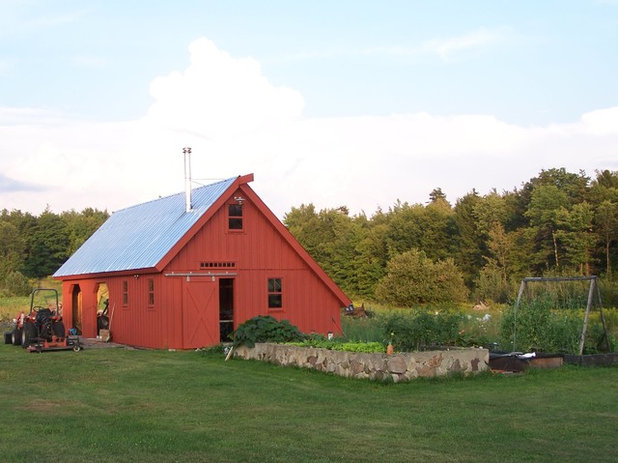
Tim McCarthy Architect PC
Take a Soil SampleJohny Crooks of Blades of Grass Lawn Care in Savannah, Georgia, says that if you go to your local big-box store and mention lawn problems like brown spots, chances are someone will lead you to the fertilizer aisle, hand you a large bag and send you on your way. This can cause all sorts of problems for your lawn and can make things much worse. Fertilizing might not be the solution, and applying too much could fry your lawn.
Before you do anything to your lawn, you need to get a soil sample to determine its pH, which is probably the biggest factor when it comes to a healthy lawn. A soil sample will also tell you whether you have clay soil or sandy soil, which will be key to how you maintain your lawn.
Justin Woodford of A Cut Above Lawn Care in West Kingston, Rhode Island, recommends taking half-cup samples of soil from 10 different spots in your yard to get a good average. You can then take these samples to your local agricultural extension or sometimes a university for testing. Crooks says some places are free, but at others you might have to pay a fee. In his area these samples are usually around $12 to analyze.
Before Photo
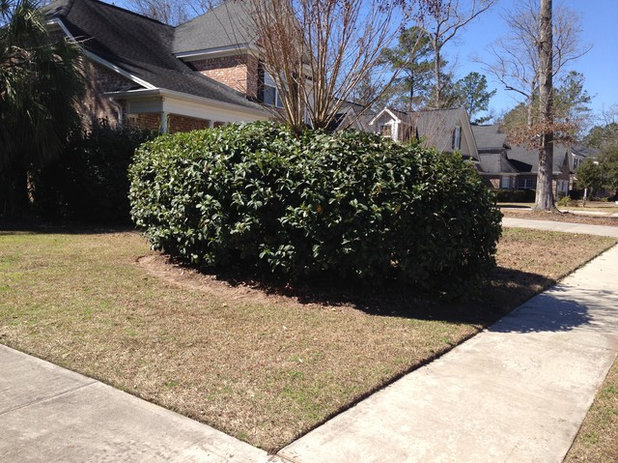
Blades of Grass Lawn Care, LLC.
If your lawn looks dried out (as in this image), is full of weeds or has yellow or brown spots, the test will tell you what your soil is lacking. Woodford says you want to shoot for a pH of 7.0. You should receive a printout of your sample that you can give to a lawn care professional, who can then come up with a recipe for improving your soil and lawn.
If your soil is imbalanced, it’s most likely that it’s more acidic rather than more alkaline. But it all depends on where you live. The pH depends on a variety of factors, including whether a previous owner had a garden. If you have an oak tree in your yard, that could be a main contributing factor to overly acidic soil. Oak tree leaves are high in acid content. When they fall to the ground and decompose in the soil, over time it can up the acidity level.
If your soil is too acidic, you’ll need to add lime to neutralize the acidity. Lime is pulverized limestone, an organic material that’s mainly calcium carbonate. If your soil is too alkaline, you’ll need to add more nitrogen, a component found in fertilizers. If your soil is lacking microorganisms, then more organic matter, like peat moss, will be needed to kick-start the topsoil.
At this stage when you’re looking to completely revitalize your lawn, it’s best to leave the care to a professional. “This is past the DIY stage,” Crooks says. The amount of lime will depend on how much calibrating the soil needs. Typically the amount needs to be a certain amount of pounds per 1,000 square feet, something a professional is trained to figure out. “Don’t just get a bag of lime and put it on the grass,” Crooks says. “That doesn’t work.”
You’ll want to continue taking a soil sample yearly to make sure it’s maintaining the right levels.

Blades of Grass Lawn Care, LLC.
Buy Seed or SodOnce you get your soil to the desirable 7.0 pH, then you can start a program to whip your lawn into shape. If you’re starting over or from scratch, then this is the time to buy grass seed or sod.
Here are the most common types of lawn grass:
- Saint Augustine. This is the most delicate, Crooks says, with really thick blades. You can’t buy seeds for this type of grass; you have to buy the sod, which makes it more expensive. Crooks recommends fertilizing Saint Augustine three times per year.
- Centipede. Crooks calls this the “poor man’s grass.” You can put down seeds on your own, and it will likely easily thrive. The seeds are a little more expensive than those for Bermuda, but easier to grow and maintain. He says you have to fertilize it only two times a year.
- Bermuda. This grass looks tough and is somewhat drought tolerant. The seeds are relatively inexpensive, but you have to fertilize four times a year.

Blades of Grass Lawn Care, LLC.
Treatments and PracticesHerbicides and pesticides. Crooks recommends adding a pre-emergent herbicide in November and every three months after to stop weeds from germinating. But it’s best to leave pesticides and herbicides to professionals. “Herbicides are nasty stuff,” Woodford says. “As a landscape contractor, we have to go through training on how to handle and use herbicides and pesticides. But any homeowner can walk into Home Depot and buy the stuff. I’m not sure why that is.”
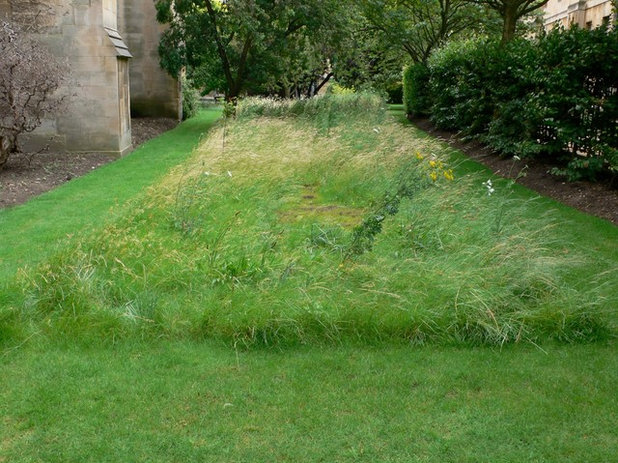
Cory Spencer Partners
Fertilizer. Fertilizer is like food for your grass. It contains nitrogen, which is essential for healthy grass. Woodford recommends fertilizing two or three times per year, depending on your soil and type of grass.
Organic methods. Woodford uses only 100 percent organic methods for fertilizing and maintaining lawns. He uses corn gluten fertilizers to prevent things like crabgrass, milky spore to kill insects, and chicken droppings to add nitrogen.
He says that if you put down chemical fertilizers, your grass can become dependent on it to thrive — meaning if you stop, your grass will die. Organic matter has micronutrients that you can’t get from chemical fertilizers and helps your grass function on its own rather than be dependent on chemicals.
To keep weeds down, he employs a program of overseeding grass to filter out weeds. It’s a combination of dethatching and dropping seeds down into the slits to filter out weeds. “The more grass that’s growing, the fewer weeds you’ll have,” he says.

Blades of Grass Lawn Care, LLC.
Aerating. If your soil is too compacted, your grass won’t grow. Compaction can happen naturally, and is more of a problem with clay soil. It occurs in high-traffic areas (where you walk or even drive a lot). If you start to feel like the grass is hard underfoot, it’s a sign that your soil is too compacted. Woodford recommends aerating at least once a year.
Dethatching. Thatch is a layer of dead grass on top of the soil. A little bit of thatch is OK, even desirable, but you want to keep it to a layer of no more than half an inch. To remove thatch, use a dethatcher lawn mower, which has blades that move vertically rather than horizontally to dig thatch out of the soil.
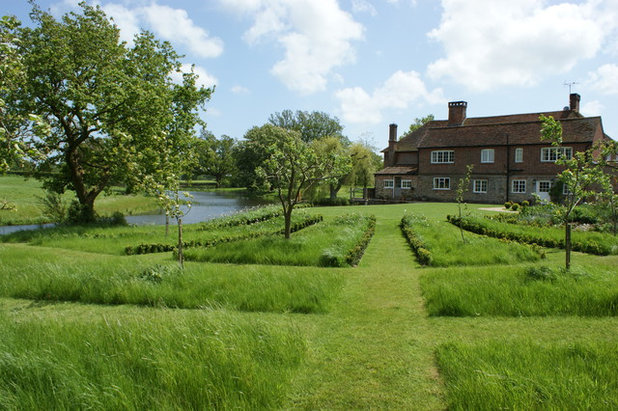
Nigel Philips
Cutting. Crooks recommends cutting just once a week, or every other week, only taking off one-third of the top of the leaves. This will allow the blades to grow at a nice, steady pace. If you cut it too low, the grass will go into survival mode and shoot out as fast as it can.
Also, it’s not recommended to bag your lawn clippings. Mulching the lawn (leaving the cut blades where they fall) puts nitrogen back into the soil. “It’s like free fertilizer,” Crooks says.
Crooks also recommends that you change your mowing pattern each week. If you cut left to right one week, switch it up and cut up and down the next. This will minimize ruts in your lawn.
Some professionals and homeowners recommend using a manual mower to cut down on fuel emissions.
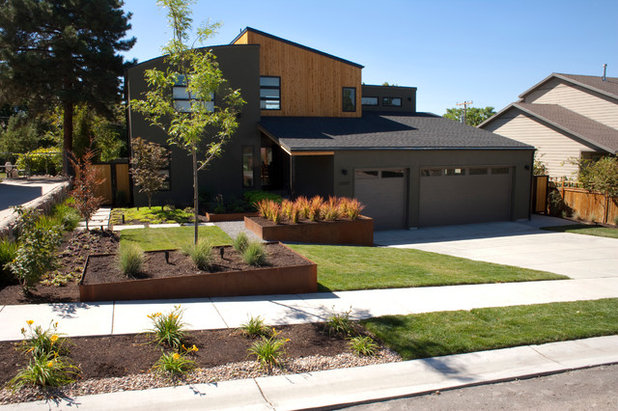
Landform Design Group
Watering. Watering depends on what kind of soil you have. Sandy soil requires more watering, because the nutrients flow through the soil. Clay soil holds water better.
New lawns need watering more often to get the seeds to grow. Established lawns should be watered infrequently but for longer periods to give the water time to soak deep into the soil and force the roots to grow deeper to reach it.
For established lawns, Woodford recommends watering two times a week depending on the weather, for about 20 to 30 minutes. For a new lawn, you’ll likely be watering daily in the mornings for 15 minutes per zone.
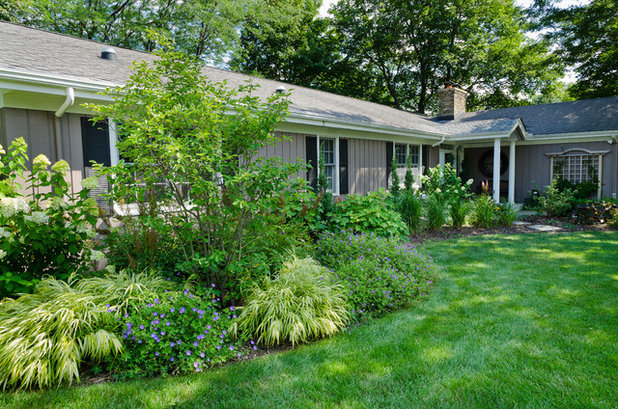
Ginkgo Leaf Studio
Other Considerations
Cost. When in doubt, it’s a good idea to call in a professional. Crooks and Woodford say you can hire a good professional to test, cut, fertilize and maintain your lawn for anywhere from $50 to $125 per month, depending on your lawn’s needs and size.
Lawn alternatives. There are numerous debates involving the use of lawns, from wasted water to chemical runoff to ecological dead zones to their just being boring. There are numerous alternatives and solutions to many of these problems (see the links below).
In the end, it’s worth keeping the debate alive and always trying to find some common ground.
See articles on saving water at home
More: Small Gem Lawns: More Impact From Less Grass
The Case for Losing the Traditional Lawn
Give Your Lawn a Taste of the Wild





